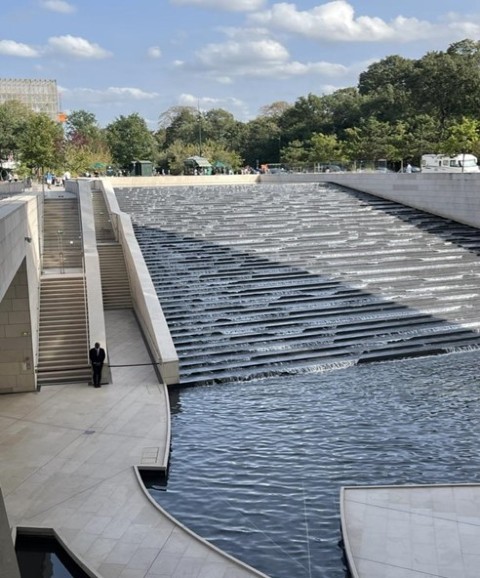
by Joan Winstein, class of 2012
Photographs by the author except as noted
Last month, I visited Fondation Louis Vuitton (FLV) in Paris. There were no exhibitions, allowing me an undistracted and clear view of the building’s structure and materials.
The museum, designed by Frank Gehry, was completed in 2013 after more than 5 years of construction; it opened the next year.
Gehry’s emphasis on conveying movement in his designs –as can be seen at the Pritzker Band Shell in Millennium Park and Disney Hall in Los Angeles as well as other structures – is particularly evident here: the museum presents as a large ship moving through water, under billowing sails.

FLV sits in a large public park, the Bois de Boulogne, at the western edge of the (tourist) center of Paris. Views overlooking the canopy of trees surrounding it are vast. Glass greenhouses dotted the park in the 19tth century, providing historical context to Gehry’s design.
Our guide pointed out that there were once artificial lakes in the park, “wonderfully described by Marcel Proust”, perhaps inspiring the water feature Gehry designed at the base. (Not having read Proust, I can’t confirm!)
It is said that Gehry especially admired the glass-roofed Grand Palais in Paris and used it as inspiration:

One enters Fondation Louis Vuitton into a large, airy atrium, underneath glass “sails” of very lightly fritted glass with huge, arching structural supports of glue-laminated larch wood and steel.

A striking water feature serves to connect the museum to the park. Water cascades down a series of stone steps from the park outside to create a pool.


At the lower level of the museum, mirrored columns reflect light from the water — and the pool is accessible from there.

From the upper floors and roof, one can see the Bois de Boulogne as well as the most famous Paris sight:


Limestone pavers – all the same size and from the Burgundy region of France — provide flooring on the terraces and plazas.

This rectangular patterning of the limestone is repeated on the siding of the “iceberg” – what Gehry termed the structural support of the building — with stark white concrete panels. Some sections are curved, as if undulating in the sea breezes.

The ”iceberg” provides support for the steel and laminated larch timbers anchoring the glass sails :



The 12 glass “sails” are, of course, the most striking feature of Gehry’s design, formed by 3,600 separate glass panels. The glass is translucent with light fritting. I imagine this also helps deflect some of the sun’s glare into the galleries.



Lastly, an internal view of the concrete and steel supported stair wells:

Although we were a bit disappointed that there was no art exhibit to view, touring FLV when the galleries were empty was a unique opportunity to really concentrate fully on the building’s architecture and appreciate Gehry’s vision.
If you visit Paris, this is a “must-see”!
For more information, there is timelapse video of the 5+ year construction at fondationlouisvuitton.fr/en/foundation/the-building. (Scroll down to the video under the section entitled “The Construction”)
CLICK HERE for more stories on The Bridge.


Timing is everything. We were there October 25, 2023, and were able to see the once in a generation Mark Rothko exhibition. In my opinion, an appropriate artist to be displayed in a Gehry designed building.
Very interesting! Thanks for sharing all the photos Joan. Visiting this museum is on my bucket list for sure…especially after I read Gehry’s biography in the CAC book club. (Great book btw).